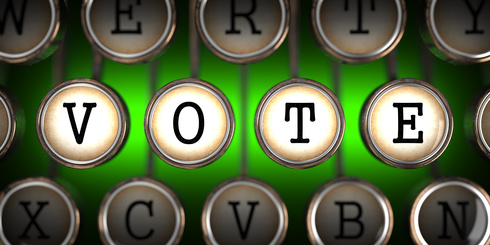The U.S. Senate primary outcome was frustrating for supporters of Rob Hogg. Despite outperforming his numbers in the Selzer poll for the Des Moines Register, Hogg finished about 8.5 percent behind front-runner Patty Judge. Tom Fiegen and Bob Krause each took about 6.7 percent of the primary votes, which arguably kept Hogg from overcoming Judge’s higher name recognition and better-funded campaign. Many activists are upset that the Democratic Senatorial Campaign Committee encouraged Judge to bigfoot Hogg in the first place.
Let’s set aside the blame game for now.
The low turnout in yesterday’s primary should alarm all Iowa Democrats, regardless of preference in the Senate race.
With only ten precincts not counted, just 97,115 ballots were cast for any Democratic candidate running against Senator Chuck Grassley. Only four months ago, more than 171,000 Iowans participated in the Democratic caucuses.
This year’s Senate primary drew more voters than the lopsided 2010 race between Roxanne Conlin, Fiegen, and Krause. Statewide Democratic turnout that year was a little more than 73,000. But in the 2006 governor’s race, the last highly competitive statewide primary for Iowa Democrats, more than 148,000 ballots were cast for Chet Culver, Mike Blouin, Ed Fallon, or Sal Mohamed.
I thought it was a bad sign for Republicans when fewer than 158,000 people cast ballots in the 2014 Senate primary, a big drop from the 227,404 people who had voted for one of the three GOP candidates for governor in June 2010. While it’s natural that a primary for an open seat in 2014 would attract more interest than a contest to see which Democrat will face Grassley, the lack of voter engagement in this year’s Senate race is noteworthy.
Yesterday’s primary settled spirited Democratic contests in two Congressional districts. Unofficial results show 30,942 people voted in the IA-01 race between Monica Vernon and Pat Murphy, and 26,113 people voted in the IA-03 race between Jim Mowrer, Mike Sherzan, and Desmund Adams. Meanwhile, the IA-04 Republican primary between Representative Steve King and State Senator Rick Bertrand drew 44,639 voters. Granted, some of those may have been Democrats crossing over for a day to take down King. Still, it’s striking that even though Bertrand won just 35 percent of the vote in his race, he had more votes than Mowrer did in winning the IA-03 primary by double digits. Moreover, the number of votes for King in IA-04 was greater than the total vote for Democratic candidates in IA-03.
Strong primary turnout doesn’t necessarily correlate with victory in November. In 2002, more than 199,000 Republicans cast ballots for one of the three candidates for governor, and more than 197,000 voted for one of the two GOP candidates for Senate. That didn’t stop Governor Tom Vilsack and Senator Tom Harkin from beating Doug Gross and Greg Ganske by wide margins.
But Vilsack and Harkin were incumbents. This year Democrats have no statewide incumbent on the ticket. “The Judge Chuck Grassley can’t ignore” will be vastly outspent as she tries to give the senator his toughest race since 1980. Vernon and Mowrer will face well-funded Representatives Rod Blum and David Young, respectively.
I think Hillary Clinton is more likely than not to beat Donald Trump in Iowa, but two relatively unpopular candidates at the top of each party’s ticket is not likely to drive record-breaking turnout. Democrats need strong participation to hold on to the Iowa Senate majority and make gains in the Iowa House.
Voters need to be motivated to support Democratic candidates, because down-ballot Republicans will do their best to distance themselves from Trump’s toxic rhetoric. GOP contenders for state legislative seats will be speaking to people directly at the doorstep. The Republican Party of Iowa will invest more in early voting, aware of how early GOTV helped Barack Obama defeat Mitt Romney here in 2012. That year, more than 43 percent of Iowans who participated cast their ballots before election day.
Yesterday’s results don’t mean Democrats will inevitably suffer from an enthusiasm gap in November, but candidates and party leaders should start thinking about how to avoid that outcome.
UPDATE: The Republican Party of Iowa sent out this press release on June 8.
Democratic Enthusiasm is in the RED
2014 GOP Senate Primary Voters: 162,633
2016 DEM Senate Primary Voters: 96,906
State Wide Democrat Enthusiasm Deficit (DED): -65,727 (68% Higher GOP Turnout)David Young Total Votes: 17,852
Jim Mowrer Total Votes: 12, 949
CD 3 Democrat Enthusiasm Deficit (DED): -2,766 (38% More Votes)CD4 GOP Primary Vote Total: 44,624
CD3 DEM Primary Vote Total: 26,133
Contested Primary Democratic Enthusiasm Deficit (DED): -18,491 (71% Higher GOP Turnout)“Being in the red is nothing new for this group of Democratic candidates. Jim Mowrer ran and lost two years ago to Steve King; Patty judge and Chet Culver ran deficits consistently in their failed administration leaving Iowans to pay their ditched tab;Hillary Clinton is struggling to get 40% of Democrats to say they will support her as of now. One thing is for sure — if Democrats are good at anything, it is running in the red.”- Jeff Kaufmann, Chairman of the Republican Party of Iowa
Looking at total turnout, about 5,000 more Iowans cast ballots in the IA-03 Democratic primary than in the Republican primary. But I would have expected a much larger disparity than that. The Democratic race had two candidates (Mowrer and Sherzan) spending heavily on direct mail and television advertising, whereas Young’s primary challenger was a joke.


1 Comment
Primary
I wasn’t able to engage in the primary banter in the way that I would like to have done. I was busy and didn’t want to upset the Fiegen people too much. IA-3 turnout was extremely low, and that surprised me.
I respect 80-90 percent of Rob Hogg’s legislative goals, but the evidence that his views fit the majority of Iowa voters is sorely lacking.
moderateiadem Sun 12 Jun 4:18 PM